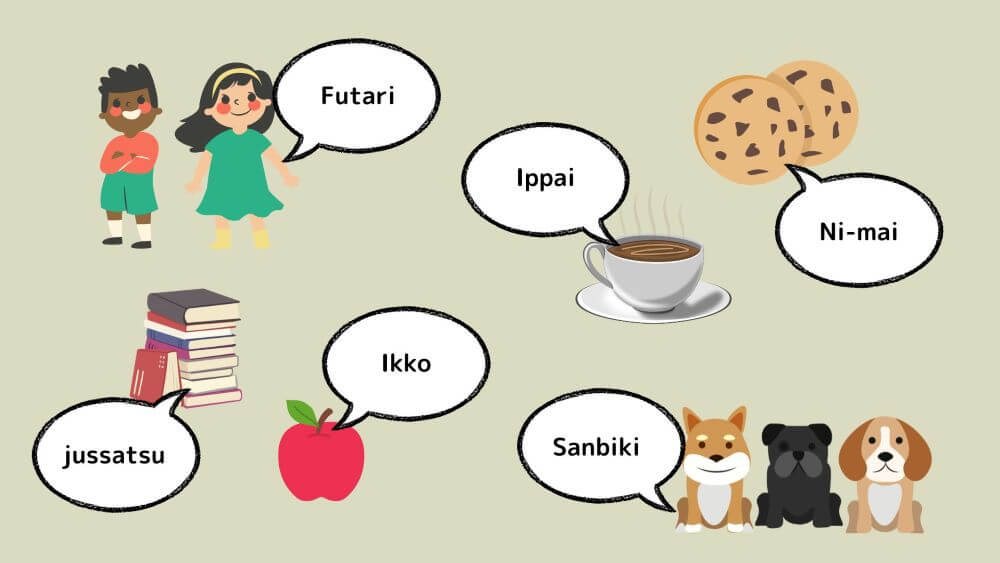One of the most challenging aspects of Japanese grammar is counting things. This difficulty arises from the wide variety of counters and the changes in pronunciation when counting. However, learning the counting units commonly used in everyday conversations will make your Japanese sound more natural. This article introduces the 13 most commonly used Japanese counters.
Essential Japanese Counters
The two most basic ways to count in Japanese are as follows. These are essential basics that you should learn first when starting with Japanese.
個 (こ) – “ko”
“Ko” is used for counting visually distinguishable items and is the most frequently used counter in daily life. It is often used as a substitute when the proper counter is unknown, and many Japanese children count almost everything using “ko.” So, if you’re unsure which counter to use, “ko” will usually help natives understand what you mean.
Example: Apples, balls, rubbish bins, cups
Counting: 1個 [ikko], 2個 [niko], 3個 [sanko], 4個 [yonko], 5個 [goko], 6個 [rokko], 7個 [nanako], 8個 [hakko], 9個 [kyūko], 10個 [jukko]
Example sentence: りんごを3個食べました。[Ringo wo sanko tabemashita.] (I ate three apples.)
つ – “tsu”
“Tsu” is used for specific items as well as vaguely defined quantities. It is highly versatile and widely used. However, “tsu” can only count up to ten and cannot be used for numbers eleven and above.
Example: Hearts, ideas, apples
Counting: 1つ [hitotsu], 2つ [futatsu], 3つ [mittsu], 4つ [yottsu], 5つ [itsutsu], 6つ [muttsu], 7つ [nanatsu], 8つ [yattsu], 9つ [kokonotsu], 10 [tō]
Example sentence: 私は2つのアイディアがあります。[Watashi wa futatsu no idea ga arimasu.] (I have two ideas.)
Frequently Used Counting Units
日 (にち) – “nichi”
Used for counting dates. “日” is read as “nichi” or “hi” when read alone, but when referring to dates, it has a very specific pronunciation, which you should simply memorise.
Counting: 1日 [tsuitachi], 2日 [futsuka], 3日 [mikka], 4日 [yokka], 5日 [itsuka], 6日 [muika], 7日 [nanoka], 8日 [yōka], 9日 [kokonoka], 10日 [tōka]
Example sentence: 明日は3日です。[Ashita wa mikka desu.] (Tomorrow is the third.)
人 (にん) – “nin”
Used for counting people. Note that the pronunciation of “人” differs when counting one or two people.
Counting: 1人 [hitori], 2人 [futari], 3人 [sannin], 4人 [yonin], 5人 [gonin], 6人 [rokunin], 7人 [shichinin], 8人 [hachinin], 9人 [kyūnin], 10人 [junin]
Example sentence: 友達が3人来ました。[Tomodachi ga sannin kimashita.] (Three friends came.)
本 (ほん) – “hon”
Used for long, slender objects. “本” is generally pronounced as “hon,” but depending on the number, it can also be pronounced as “pon” or “bon.” Also, the numbers sometimes become geminated, as in “1本,””6本,” or “10本.”
Countable items: Pencils, sticks, hair etc.
Counting: 1本 [ippon], 2本 [nihon], 3本 [sanbon], 4本 [yonhon], 5本 [gohon], 6本 [roppon], 7本 [nanahon], 8本 [hachihon], 9本 [kyūhon], 10本 [juppon]
Example sentence: ペンが一本あります。[Pen ga ippon arimasu.] (There is one pen.)
番 (ばん) – “ban”
Used to indicate position or order in a sequence.
Countable items: Ranking, line, adress
Counting: 1番 [ichiban], 2番 [niban], 3番 [sanban], 4番 [yonban], 5番 [goban], 6番 [rokuban], 7番 [nanaban], 8番 [hachiban], 9番 [kyūban], 10番 [juban]
Example sentence: 彼は今大学で1番成績が良いです。[Kare wa ima daigaku de ichiban seiseki ga yoi desu.] (He has the best grades in the university now.)
枚 (まい) – “mai”
Used for thin, flat objects.
Countable items: Paper, coin, leaf, plates, bills, photographs etc
Counting: 1枚 [ichimai], 2枚 [nimai], 3枚 [sanmai], 4枚 [yomai], 5枚 [gomai], 6枚 [rokumai], 7枚 [nanamai], 8枚 [hachimai], 9枚 [kyūmai], 10枚 [jumai]
Example sentence: 写真を2枚撮りました。[Shashin wo nimai torimashita.] (I took two photos.)
匹 (ひき) – “hiki”
Used for small animals. “匹” is generally pronounced as “hiki,” but depending on the number, it can also be pronounced as “piki” or “biki.” In addition, multiple pronunciations might exist for some counters, for example “6匹” can be counted as “rokuhiki” or “roppiki,” and “8匹” can be counted as “hachihiki” or “happiki.”
Countable items: Dogs, cats, mosquitoes
Counting: 1匹 [ipiki], 2匹 [nihiki], 3匹 [sanbiki], 4匹 [yonhiki], 5匹 [gohiki], 6匹 [rokuhiki], 7匹 [nanahiki], 8匹 [hachihiki], 9匹 [kyūhiki], 10匹 [juppiki]
Example sentence: 猫が3匹います。[Neko ga sanbiki imasu.] (There are three cats.)
杯 (はい) – “hai”
Used for counting drinks in containers. The counter “杯” is generally read as “hai,” but it can be pronounced as “pai” depending on the number. Also, the numbers sometimes become geminated, as in “1杯,””6杯,” or “10杯.”
Countable items: Water, beer, juice
Counting: 1杯 [ippai], 2杯 [nihai], 3杯 [sanpai], 4杯 [yonhai], 5杯 [gohai], 6杯 [roppai], 7杯 [nanahai], 8杯 [hachihai], 9杯 [kyūhai], 10杯 [juppai]
Example sentence: コーヒーを1杯飲みます。[Kōhī wo ippai nomimasu.] (I will drink one cup of coffee.)
回 (かい) – “kai”
Used for counting occurrences. The numbers sometimes become geminated, as in “1回,””6回,” “8回,” or “10回.”
Counting: 1回 [ikkai], 2回 [nikai], 3回 [sankai], 4回 [yonkai], 5回 [gokai], 6回 [rokka], 7回 [nanakai], 8回 [hakkai], 9回 [kyūkai], 10回 [jukkai]
Example sentence: 会議は3回延期されました。[Kaigi wa sankai enki saremashita.] (The meeting was postponed three times.)
階 (かい) – “kai”
Used for counting floors of a building. The numbers sometimes become geminated, as in “1階,””6階,” “8階,”” or “10階.” Note that ‘回’ for counting occurrences and ‘階’ for counting floors have the same pronunciation.
Counting: 1階 [ikkai], 2階 [nikai], 3階 [sankai], 4階 [yonkai], 5階 [gokai], 6階 [rokkai], 7階 [nanakai], 8階 [hakkai], 9階 [kyūkai], 10階 [jukkai]
Example sentence: 部屋は3階です。[Heya wa sankai desu.] (The room is on the third floor.)
歳 (さい) – “sai”
Used for counting age. The numbers sometimes become geminated, as in “1歳,””8歳,”” or “10歳.”
Counting: 1歳 [issai], 2歳 [nisai], 3歳 [sansai], 4歳 [yonsai], 5歳 [gosai], 6歳 [rokusai], 7歳 [nanasai], 8歳 [hassai], 9歳 [kyūsai], 10歳 [jussai]
Example sentence: 子供が5歳になりました。[Kodomo ga gosai ni narimashita.] (The child turned five years old.)
冊 (さつ) – “satsu”
Used for counting books. The numbers sometimes become geminated, as in “1冊” or “10冊.”
Counting: 1冊 [issatsu], 2冊 [nisatsu], 3冊 [sansatsu], 4冊 [yonsatsu], 5冊 [gosatsu], 6冊 [rokusatsu], 7冊 [nanasatsu], 8冊 [hachisatsu], 9冊 [kyūsatsu], 10冊 [jussatsu]
Example sentence: 本を3冊買いました。[Hon wo sansatsu kaimashita.] (I bought three books.)
Tips for Learning Japanese Counters

Japanese counters come in various forms, and even native speakers don’t know them all. When studying Japanese counters, focusing on the following points can help you learn more efficiently:
As mentioned earlier, mastering all Japanese counters is nearly impossible. However, by understanding the ones commonly used in daily conversations, you can achieve natural Japanese speech. It’s important to start with the basic counting methods and gradually become accustomed to them.
Let’s DANGO introduce effective ways to improve your Japanese language skills. We hope this article will be helpful for your Japanese learning journey.


